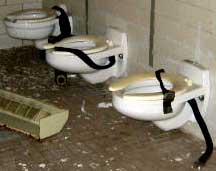-safety
Always wear your safety belt!
Falling
Some exploration requires climbing or being in high places. We try to avoid most of this stuff, but do be careful and wear shoes with good traction. (Gloves come in handy, too.)Unstable Architecture and Structures
Rotten floors, duct work, walls and ceilings are a hazard in certain places, and are one reason why hard hats and steel toe/shank boots should be worn. Exploring also may involve crawling through openings, tunnels, manholes and other confined spaces.Drowning
To die by suffocating in water or another liquid.
In Chicago, water can cause problems, particularly during the rainy season (when is that exactly?) Water can rise quickly, as a result of snow melt or thunderstorms. Always be alert to your surroundings and weather while draining. In case of an emergency, know where your nearest exit is.Getting Stuck
To become fixed, blocked, checked, or obstructed:
Snags and rips to your clothes are typical problems that every explorer faces. Getting stuck somewhere should not be. Entering a tight area might happen once in a very great while. We travel in small groups and NEVER leave anyone behind. (Scouts honor!)Claustrophobia and Paranoia
Claustrophobia is usually described as a fear of enclosed places. A more accurate description might be 'a fear of not having an easy escape route' because for anyone who experiences this phobia this is the predominating feature - you feel a need to be able to get out or get home, quickly. Paranoia is a term used by mental health specialists to describe suspiciousness (or mistrust) that is either highly exaggerated or not warranted at all.
Overestimated hazards, in our experience. Every beginner says that he/she is "a bit claustrophic", but we've never known of anyone seriously freaking from it. Just keep away from the tighter spots and keep out of sight for your first few trips until you get comfortable with exploring.
As for paranoia, it's the rush BABY YEAH! Without our natural paranoia kicking in, we might do something stupid, so don't feel bad if you're a bit "freaked". I look at urban exploration as a way to overcome one's fears, build character, have something unusual to talk about at the next "dinner party" and get a good workout while doing it.Getting Lost
It's big out there! And wild! To avoid the hazards of getting lost...research your trip before you hit the streets! Thanks to topo maps (now published on the internet), GPS systems, cell phones and Palm Pilots...this shouldn't be a problem. If worse comes to worst, you can always leave a trail of breadcrumbs....I prefer Light Rye.Light
It's a kind of energy called "electromagnetic (EM) radiation" (but this kind of radiation is not harmful, except for an occasional sunburn). There are other kinds of EM radiation too (radio waves, microwaves, x-rays, etc.), but light is the part WE can see and you won't be seeing much if you don't have a flashlight!
Take at least three, trustworthy, light sources and extra batteries. Even on a bright sunny day a boarded up old building can be as dark as any cave! SERIOUSLY!Sub-Urban Hazards
Ticks, poison ivy/oak, snakes, opossums, cops, dogs, spiders, ticks, mosquitos, raccoons, shot-guns, and dogs with bees in their mouths
+
UE
SUPPLIES
FOOTWARE
boots
steel-toe
mud boots
waders
extra socks
CLOTHING
gloves
old loose fitting jeans
hand-me-downs
second hand
grunge clothes
rain coats
sweats
loose fitting coats
layers
FOOD
water
granola
energy bars
TOOLS
2-3 flashlights
headlamp
several batteries
army knife
rope
carabiners
compass
GPS
FIRST
AID
antibiotic ointment
surgical gloves
sterile bandages
scissors
tweezers
Q-tips
aspirin/motrin
antihistamine
MISC
map
camera
flash
trash bags
zip lock bags
toilet paper
hat
helmet/hard hat
backpack
pen/marker
sunscreen
insect repellant
watch
safety glasses
sun glasses
lighter
waterproof matches











